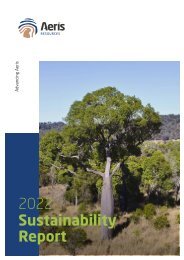Aeris Annual Report 2022
Create successful ePaper yourself
Turn your PDF publications into a flip-book with our unique Google optimized e-Paper software.
<strong>Aeris</strong> Resources Limited<br />
Notes to the consolidated financial statements<br />
30 June <strong>2022</strong><br />
37. Significant accounting policies (continued)<br />
An asset is classified as current when: it is either expected to be realised or intended to be sold or consumed in the<br />
consolidated entity's normal operating cycle; it is held primarily for the purpose of trading; it is expected to be realised<br />
within 12 months after the reporting period; or the asset is cash or cash equivalent unless restricted from being<br />
exchanged or used to settle a liability for at least 12 months after the reporting period. All other assets are classified as<br />
non-current.<br />
A liability is classified as current when: it is either expected to be settled in the consolidated entity's normal operating<br />
cycle; it is held primarily for the purpose of trading; it is due to be settled within 12 months after the reporting period; or<br />
there is no unconditional right to defer the settlement of the liability for at least 12 months after the reporting period.<br />
All other liabilities are classified as non-current.<br />
Deferred tax assets and liabilities are always classified as non-current.<br />
Derivative financial instruments<br />
Derivatives are initially recognised at fair value on the date a derivative contract is entered into and are subsequently<br />
remeasured to their fair value at each reporting date. The accounting for subsequent changes in fair value depends on<br />
whether the derivative is designated as a hedging instrument, and if so, the nature of the item being hedged.<br />
The consolidated entity designates certain derivatives as either:<br />
● hedges of the fair value of recognised assets or liabilities or a firm commitment (fair value hedges)<br />
● hedges of a particular risk associated with the cash flows of recognised assets and liabilities and highly probable<br />
forecast transactions (cash flow hedges).<br />
At inception of the hedge relationship, the consolidated entity documents the economic relationship between hedging<br />
instruments and hedged items including whether changes in the cash flows of the hedging instruments are expected to<br />
offset changes in the cash flows of hedged items. The consolidated entity documents its risk management objective and<br />
strategy for undertaking its hedge transactions. The fair values of derivative financial instruments designated in hedge<br />
relationships are disclosed in note 16. Movements in the hedging reserve in shareholders’ equity are shown in note 21.<br />
The full fair value of a hedging derivative is classified as a non-current asset or liability when the remaining maturity of<br />
the hedged item is more than 12 months; it is classified as a current asset or liability when the remaining maturity of the<br />
hedged item is less than 12 months. Trading derivatives are classified as a current asset or liability.<br />
(i) Cash flow hedges that qualify for hedge accounting<br />
The effective portion of changes in the fair value of derivatives that are designated and qualify as cash flow hedges is<br />
recognised in the cash flow hedge reserve within equity. The gain or loss relating to the ineffective portion is recognised<br />
immediately in profit or loss, within other gains/(losses).<br />
Amounts accumulated in equity are reclassified in the periods when the hedged item affects profit or loss.<br />
When a hedging instrument expires, or is sold or terminated, or when a hedge no longer meets the criteria for hedge<br />
accounting, any cumulative deferred gain or loss and deferred costs of hedging in equity are immediately reclassified to<br />
profit or loss.<br />
Joint operations<br />
A joint operation is a joint arrangement whereby the parties that have joint control of the arrangement have rights to the<br />
assets, and obligations for the liabilities, relating to the arrangement. The consolidated entity has recognised its share of<br />
jointly held assets, liabilities, revenues and expenses of joint operations. These have been incorporated in the financial<br />
statements under the appropriate classifications.<br />
AERIS ANNUAL REPORT <strong>2022</strong><br />
48<br />
124





